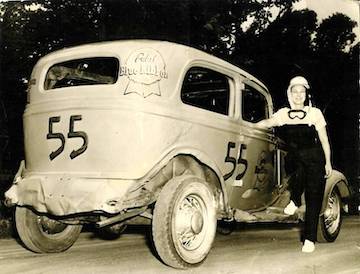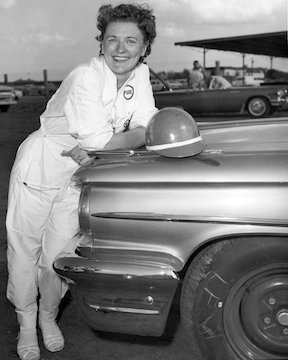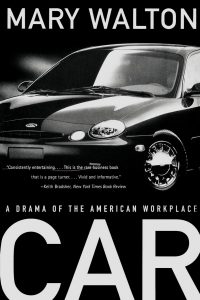I was recently asked to submit a chapter on women and motorsports to include in an upcoming collection of essays on motorsports history. As the subject is quite broad, I chose to focus on women-only racing. What follows is an excerpt from ‘From Powder Puff to W Series: the Evolution of Women’s Only Racing’ from Life in the Fast Lane: Essays on the History and Politics of Motor Racing [manuscript in press].

Over the past 70 years, ‘powder puff’ has served as an umbrella term to describe women-only competitions in sports – football the most notable example – traditionally associated with male athletes. In motorsports, the phrase most often refers to contests performed in a variety of venues and vehicles in which women compete separately from men. The use of powder puff to describe ladies-only auto races appears to have its origins in the late 1940s and early 1950s.[1] Small town newspapers, reporting results from the local racetrack, would call upon the term to qualify and single out women’s participation.[2] The special ladies races were created to address a number of concerns. Women who accompanied boyfriends or husbands to the track often had little to do once arriving but watch and wait. In the masculine world of motorsports, women served primarily as uniform washers, picnic lunch makers, and cheerleaders to their male companions. Or they might be assigned to [unpaid] duties as ticket takers, award presenters, or disc jockeys who changed music between races. Given that race officials often treated women as ‘less important than the cars in attendance,’ it is not surprising that female interest in the race experience soon began to wane (Cabatingan, 2013).
Race promotors – fearful women’s lack of enthusiasm would keep boyfriends and husbands from bringing cars to the track – saw an opportunity to keep the women occupied and in the process, increase the gate. Girlfriends and wives were encouraged to ‘borrow’ cars from male companions and race against each other as a special attraction.[3] On most tracks, the races were often more spectacle than serious competition. Auto writer Standbridge (1988, p. 77) recalls, ‘the women also had to participate in a “Gong Show” type agenda. […] they might have to run so many laps, stop to eat a piece of watermelon, run up into the stands and kiss the man of their choice, then resume the race. Or stop after so many laps to wrestle with a greased pig.’ [4] Powder Puff, notes Cabatingan (2013), ‘were the type of events in which women were treated as less significant and where the men would kindly lend their race cars to women for just a few laps around the track. Clearly, women competitors were not taken very seriously.’
Powder Puff events also served to appease male egos under a pretense of gender equality. While many women desired to test their skills by competing against male drivers, procedures in place often made it impossible to do so. Of women’s SCCA races, contest board representative Ignazio Lozana Jr (qtd in Hull, 1958, p. 104) explained, ‘very few of our women drivers have a car to drive during the men’s races, since they are usually being driven by a man in those events. Should we discontinue the ladies’ races, it would mean we would have at the most two or three women drivers in our program, whereas in the ladies’ races we have had as many as 25 starters.’ While the explanation suggests ladies races were implemented to increase female participation, retaining men’s interest and involvement in racing was no doubt a greater concern.
Powder Puff participants often had very little driving experience, but were encouraged to get behind the wheel to show support for a male companion’s motorsports hobby. [5] While some men were reluctant to hand over the keys to unschooled wives or girlfriends, most viewed women’s participation as a way to gain approval – if not rationalization – for their own racing addiction. To the majority of 1950s women, taking part in a racing event was a somewhat intimidating prospect. Thus some participated hesitantly, more interested in displaying support than winning trophies. At the Reading Fairgrounds, driver Nancy Delp was loaned a car from a male participant for the Powder Puff competition. As she reminisced, ‘I had to use a sofa cushion so I could see out the window and once the race began, it was easy to realize that racing looks easier from the grandstand. It was fun, but once and done’ (qtd. in Kline, n.d.).
While the majority of Powder Puff competitors were introduced to racing by husbands and boyfriends, a few came to the track with a fervent desire to become competitive and legitimate race drivers. Notes stock car aficionado Ladabouche (n.d.), ‘I can clearly recall the intense interest and pride with which the Catamount Stadium powder puff competitors armed themselves when they would enter one of that track’s somewhat regular female races.’ However, because most tracks prohibited women from racing against men, Powder Puff competitions became the primary way to develop confidence behind the wheel, gain track experience, hone racing skills and strategies, and ‘show the guys that they could do it, too’ (McCarthy, 2007, p. 210).

Lawrence photo
Women’s passion for racing came from a variety of sources. Some were exposed to cars through male family members.[6] Women connected to men in the sport had a distinct advantage over those who did not, particularly when it came to acceptance within the motorsports community. Explains Kreitzer (2017, p. 210), ‘female racers relied heavily on male relatives who were already accepted as racing insiders to help jump start their racing careers.’ Others, while growing up with a love of cars, did not consider racing until the opportunity presented itself. Vicki Wood – after watching an all-woman’s race at the Motor City Speedway – was convinced she could drive better; she subsequently entered a race on her husband’s dare. Auto journalist Denise McCluggage, writes Roberts (2015), ‘persuaded her editors that she could better report on auto racing from behind the wheel than in the press box.’ Yet due to track restrictions, McCluggage began her racing career in Powder Puff derbies, which, as she remarked, ‘seemed to me rather like mud wrestling, staged as a spectacle for men to chuckle over rather than serious competition. But it was a chance to drive, so I put up with the hair-pull aspects’ (qtd in McCarthy, 2007, p. 147). In the minds of many female racers, ladies races provided the opportunity to ‘earn the respect of the men so they could eventually drive in any race’ (McCarthy, 2007, p. 210).
Powder Puff women had to navigate significant obstacles. Although racing during this period was an amateur sport, it could be expensive. The price of entry fees, sponsorships, equipment, maintenance, and upkeep could add up quickly. Women rarely had cars or equipment of their own, so had to beg or borrow cars, helmets, and any necessary racing gear from husbands, brothers, or complete strangers. Auto maintenance was an issue, as husbands or significant others wouldn’t always be available or willing to help with car repairs or upkeep. Although Powder Puff events varied from state to state, and track to track, they were all regulated by men, who, as Forsyth (2016, p. 174) asserts, kept a tight hold on races and ‘steadfastly refused to let the women have more time or more races.’

New York Times photo
Yet despite the barriers women encountered, racing often had a positive and powerful effect on their lives. Interviews conducted by Hull (1958) with fellow SCCA members suggest that women raced not only to support male companions, but also to expand social networks, gain confidence, and escape from everyday lives. Powder Puff provided women with the opportunity to develop advanced driving skills, make important contacts, gain a little notoriety, and prove themselves as serious racers. Many female racers of this era who went on to achieve a number of ‘firsts’ in women’s motorsports – Louise Smith, Vicki Wood, Denise McCluggage, Josie von Newmann, and Sara Christian – began racing careers in Powder Puff.
Other than premier events such as the Indianapolis 500 and NASCAR championship, American postwar racing was primarily an amateur pastime. Races were run for trophies; cash prizes were banned, as were donations from sponsors, car makers, owners, or local businesses. It was up to each driver to finance his or her racing habit. While the conditions under which men and women raced were not the same – women received less track time and had fewer and shorter races than male counterparts – all racers were held to the same restrictions in terms of sponsorships and financial remuneration.
As the decade concluded, top drivers from the sports car circuit were being lured by the considerable cash prizes of Formula 1 and international competition. US racing organizations fought back by creating racing events with comparable financial awards. Smaller venues – losing top drivers and paying crowds – sought sponsors in order to stay in business. While the move toward the commercialization of motorsports affected all amateur racers regardless of gender, it was ultimately responsible for the decline of all-female racing. Powder Puff events – and the women who participated in them – were not regarded as legitimate and as such, were unable to attract commercial support. Without amateur ladies races, women lost an important platform from which to gain experience and exposure.[7]
[1] In 1882, Ellene Alice Bailey was granted a patent for the powder puff, a soft, cosmetic pad used to apply powder to the skin from which the women’s race drew its name.
[2] In his collection of stock racing memorabilia from the 1950s, Easton (2014, p. 27) includes a ticket admission stub from the Big Flats Airport Speedway in which ‘Ladies Powder-Puff Race’ is listed as a special event alongside the ‘rollover of a stock automobile off a ramp!’
[3] Women’s race result documents from pre-1960 auto racing in Kansas from collector Bob Lawrence (n.d.) make note of vehicles shared by husbands and wives. As an example, ‘Harriett M. (Knauf) Lewis of Dighton, Kansas placed in fifth place in a Powder Puff Derby at McCarty Speedway in Dodge City on June 2, 1956 driving car #97 normally driven by her husband, Lyle E. Lewis.’ Powder Puff racing could also lead to romance, as indicated in this notice: ‘Betty Ann (Gibson) Trahern of Sublette, Kansas drove in a Powder Puff Derby run at McCarty Speedway in Dodge City, Kansas on June 2, 1956. She also finished fourth of eight cars that competed in a 10-lap Powder Puff Derby at the Grant County Fairgrounds at Ulysses, Kansas on August 8, 1958. In both of these races, she was driving a #80 jalopy normally driven Stanley Trahern whom she married between those two race dates.’
[4] The Gong Show was an amateur talent contest which aired for 13 years on American television. Three celebrities auditioned a series of acts – many of them outrageous – and unceremoniously dismissed the ‘losers’ by striking a large gong.
[5] SCCA racer Mull (1958, p. 11) writes, ‘there is no use denying the fact that most women who go in for racing do so because their husbands or someone they are fond of is interested in the sport and, rather than have another woman snap up their men or be a sports-car widow, they go along.’
[6] As an example, Ileen Merle Dessie (Forrest) Goodman, grew up in a family – 3 brothers and an uncle – of prominent auto racers. She started competing in Powder Puff races in 1949 at Cejay Stadium in Wichita, Kansas, becoming the woman’s champion that year. (Lawrence, n.d.).
[7] While Powder Puff events are still held today, the majority are fundraisers for charities such as Races Toward a Cure [breast cancer] and the American Cancer Society.
References
Cabatingan, M. (2013, April 23). Race to equality: history of women in racing. Sports Car Digest. Accessed September 9, 2020 .
Easton, F. (2014) Stock car racing in the ‘50s: pictures and memories from Western New York and Northwestern Pennsylvania. Kiernen, J. (ed.) Ford Easton.
Forsyth, D. (2016) Denver’s Lakeside Amusement Park: from the white city beautiful to a century of fun. Boulder: University Press of Chicago.
Hull, E. (1958) Women in Sports Car Competition. New York: Sports Car Press.
Kline, B. (n.d.) Mountain folklore: Remembering the Powder Puff races at Reading Fairgrounds. Reading Eagle Accessed June 4, 2020.
Kreitzer, A. (2017) Masculinity, whiteness, and technological play in dirt track automobile racing, 1924-1960, Dissertation, University of Delaware.
Ladabouche, B. (n.d.) Powder Puff races were a sign of past times in local car racing. Bill’s Back in Time. Accessed June 4, 2020.
Lawrence, B. (n.d.) Women drivers in Kansas auto racing prior to 1960. Bob Lawrence’s Vintage Auto Racing Web Ring. Accessed July 5, 2020.
McCarthy, T. (2007) Fast women: the legendary ladies of racing. New York: Hyperion.
Standridge, J. (1988) ‘Childbirth is easier than losing a ride’, Open Wheel, 8(10), p. 77.

